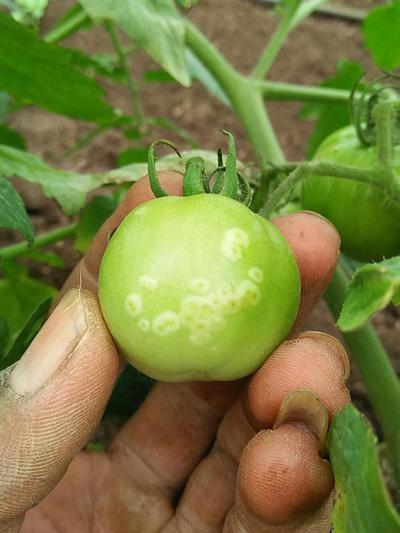Bacterial Canker of Tomato
Clavibacter michiganensis subs. michiganensis
Bacteria
In a Nutshell
- Yellowing, curling and wilting of leaves - start from margins.
- Brown spots with halo on fruits.
- Rotton stalk with vertical stripes.
- Stem splits.
Can also be found in
Symptoms
Infected seedlings produce weak, stunted plants with small whitish spots on leaf veins and petioles. Symptoms in mature plants can be due to the spreading of a primary infection to new tissues (systemic) or resulting from secondary infections. Interveinal chlorosis, curling and wilting of older leaves (sometimes only on one side) characterize the systemic spreading. Later on, the leaves eventually turn brown and collapse. Petiole usually remain green and firmly attached to the stem. New infections are characterized by dark brown lesions at the leaf margin and round spots with a bright halo on the leaf blade. The stalk base is rotten and dark-brown and brown vertical stripes appear on the upper part. Stem later split forming long, brown cankers. On the fruits, brown spots with a bright halo appear. As the disease progresses, the whole plant dessicates.
Recommendations

Organic Control
Soak the seeds in 8% acetic acid or 5% hydrochloric acid. You can also use methyl bromide or water treatments.

Chemical Control
Always consider an integrated approach with preventive measures together with biological treatments if available. Under conditions of frequent rainfall and prolonged wet periods, the use of sprays with bactericides may be justified. These can reduce the incidence of foliar blight and fruit spotting. If preventive measures are followed, the application of copper-based products offer little added benefits since localized infections pose a small economic threat.
What caused it?
The bacteria can survive on seeds, in plant residues or in the soil. The transmission occurs via infected seeds, pathogens in the soil, or during pinching. The bacteria multiply in the leaf veins and hinder water and nutrient transport. As a result, the plant starts wilting and withering. Conditions of high soil moisture or relative humidity and warm temperatures (24 to 32°C) favor the development of the disease.
Preventive Measures
- Chose certified disease-free seeds or transplants.
- If available, choose resistant varieties.
- Soilless medium in plastic trays can be used instead of field facilities to produce transplants.
- If possible, steam sterilize seedbeds and soils to kill the bacteria.
- Keep your tools and equipment clean.
- Remove weeds belonging to the Solanaceae family.
- Monitor fields and cut off diseased plants at the ground line.
- Rotate tomatoes with non solanaceous crops for at least two or three years.
- Plow deep after harvest and bury infected crop residue.



